Why Understanding Silver Round vs Coin Matters for Your Investment
Silver round vs coin represents one of the most important decisions for new precious metals investors. While both contain .999 fine silver, they differ significantly in who makes them, their legal status, and what you'll pay.
Quick Answer:
- Silver Coins: Government-minted, legal tender with face value, higher premiums, better liquidity
- Silver Rounds: Privately-minted, no face value, lower premiums, more silver for your dollar
- Best Choice: Depends on your goals - coins for recognition and resale, rounds for maximum silver weight
The fundamental difference comes down to authority. Silver coins are struck by government mints like the U.S. Mint or Royal Canadian Mint, giving them legal tender status and a face value. Silver rounds are produced by private mints and have no monetary value beyond their silver content.
This distinction affects everything from pricing to resale value. Government-backed coins typically carry higher premiums due to their official status and collectibility. Private rounds offer lower premiums, allowing you to acquire more silver for the same investment.
Understanding these differences helps you avoid overpaying and ensures your silver investment aligns with your goals—whether that's maximizing silver weight, building a diverse portfolio, or prioritizing liquidity for future sales.
With a decade of Wall Street experience, I now help individual investors steer the silver round vs coin decision for their precious metals portfolios. My experience structuring defensive strategies translates directly to helping everyday investors choose between these two silver investment options.
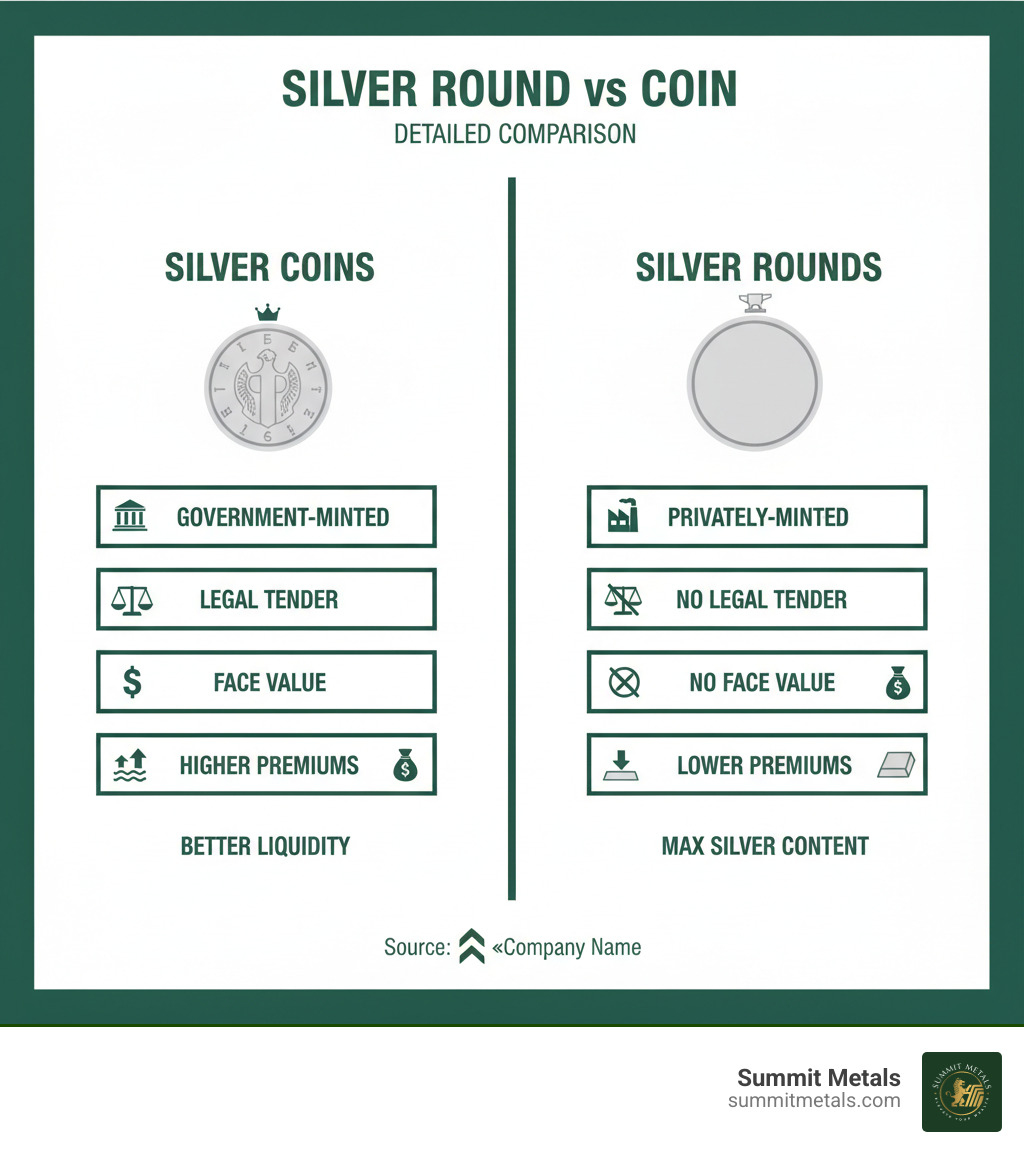
Silver round vs coin terminology:
- American silver eagle
- investing in bullion
- precious metals storage
What is the Fundamental Difference? Coin vs. Round Defined
If you're new to silver investing, you've probably wondered about the real difference between a silver round vs coin. They look similar and are both made of .999 fine silver, but the key distinction lies in who made them and what authority backs them. One has the full backing of a government, while the other is a private company's creation. This single distinction impacts everything from pricing to resale value.
Silver Coins: Government-Backed Legal Tender
When you hold a silver coin, you're holding official government currency. These are legal tender minted by sovereign government institutions like the U.S. Mint or Royal Canadian Mint.
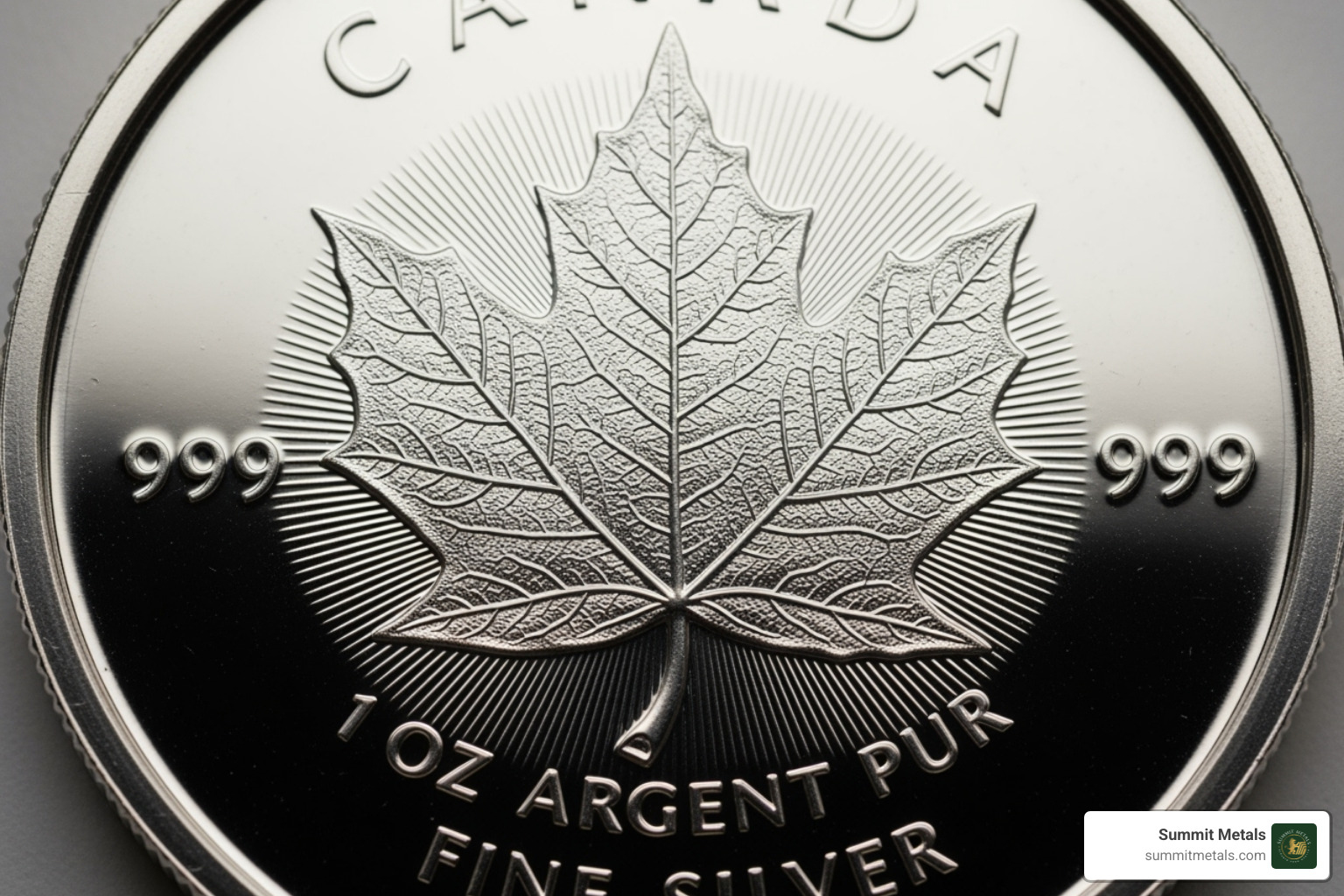
Every silver coin carries a face value—for example, "$1" on an American Silver Eagle. While the silver value is much higher, this denomination gives it official currency status. More importantly, the government guarantees the weight and purity of every coin. An American Silver Eagle is guaranteed by the U.S. government to contain one troy ounce of .999 fine silver—a promise private mints cannot make.
Government coins also feature national symbols, heads of state, and specific mint marks indicating where they were made.
For a deep dive into America's most popular silver coin, check out our comprehensive guide: Silver Eagle Bullion Coin Explained: Everything You Need to Know.
Silver Rounds: Privately Minted Bullion
Silver rounds are products of private mints—companies that create beautiful silver pieces without government involvement.
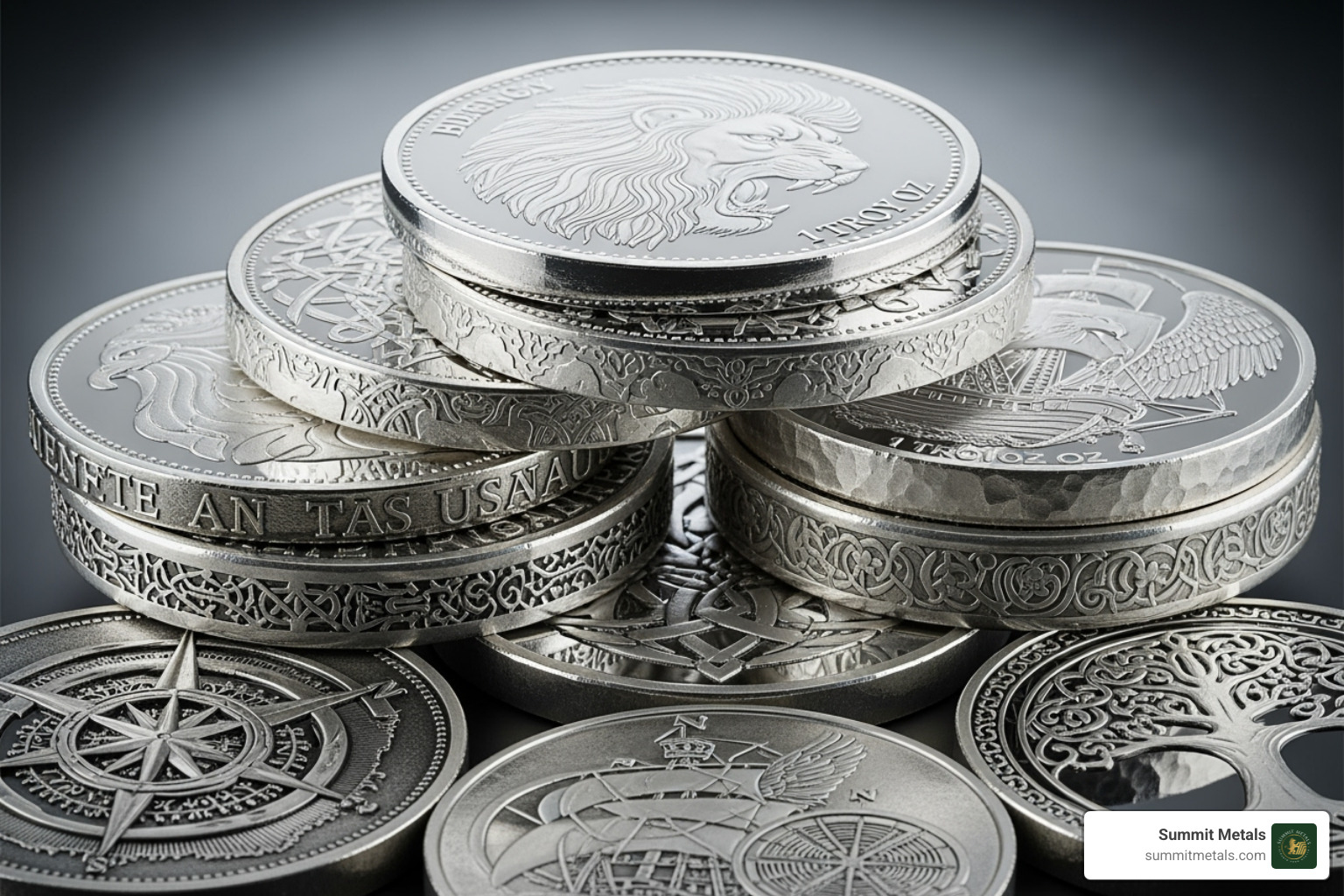
Here's what makes rounds unique: they have no face value and no legal tender status. Their value comes almost entirely from their silver content and the current spot price of silver. The big advantage is design flexibility. Without government restrictions, private mints can create rounds celebrating historical events, wildlife, pop culture, or even replicating classic coin designs (marked with "COPY" as required by law).
This creative freedom allows you to build themed collections while still investing in precious metals. The trade-off is simple: you get more silver for your dollar with rounds since they carry lower premiums, but you give up the government backing and instant global recognition that coins provide.
Ready to explore the diverse world of silver rounds? Our guide Get Your Rounds in: Where to Purchase Silver Rounds will help you steer your options.
Silver Round vs Coin: An Investor's Comparison
Now that we've covered the basics, let's dive into what really matters for your wallet. The silver round vs coin decision directly impacts how much silver you can buy, what you'll pay, and how easily you can sell later.
Premiums and Pricing: Getting More Silver for Your Dollar
Here's where the rubber meets the road. The premium is what you pay above the current spot price of silver—and this is where rounds and coins part ways dramatically.
Silver rounds consistently offer lower premiums, often just $2-4 over spot price. Private mints have lower overhead costs and aren't paying for official government backing. If your goal is to stack as much physical silver as possible, rounds deliver more ounces for your investment dollar.
Silver coins carry higher premiums—typically $4-8 or more above spot. You're not just paying for the government's stamp; you're investing in a guarantee of weight and purity, global recognition, and superior liquidity in the resale market.
Production costs tell part of the story. Government mints operate with strict quality controls and security measures that drive up costs, while private mints can produce rounds more efficiently.
Here's the key insight: rounds maximize your silver weight per dollar spent, while coins balance silver content with additional investment benefits.
Collectibility and Numismatic Value
This is where things get interesting beyond just the silver content. Numismatic value refers to worth beyond the metal—the collector's premium. Government coins have a natural advantage here because of their official status, limited mintages, and historical significance. Some coins, like proof coins with mirror-like finishes, develop serious collector followings that can push their value well beyond their silver weight.
Silver rounds aren't left out of the collectibility game. Private mints use their design freedom to produce themed series that attract dedicated collectors. The difference is that round collectibility tends to be more niche and design-specific rather than broadly market-driven.
For investors interested in potential appreciation beyond silver price movements, coins with numismatic potential offer more upside. Our Your Ultimate Guide to Buying Silver Coins Online explores this collector aspect in greater detail.
Liquidity and Resale Value: Cashing Out Your Investment
When it's time to sell, government backing really shines. Global recognizability is the coin's secret weapon. Walk into any coin shop worldwide with American Silver Eagles or Canadian Maple Leafs, and you'll get instant recognition. This widespread recognition translates directly to better liquidity and higher buyback prices.
Government backing builds immediate trust, removing guesswork about weight, purity, or authenticity. This confidence typically means coins fetch higher percentages of their spot value when you sell.
Popular rounds from reputable private mints can still offer good liquidity. The Buffalo design is so widely recognized that many dealers treat it almost like a government coin. However, less common rounds might require more shopping around to find the right buyer.
The bottom line: if easy resale and maximum recovery of your investment is a priority, government coins have a clear advantage.
Security, Authenticity, and IRA Eligibility
When investing in silver, knowing your investment is genuine and secure is paramount. The silver round vs coin debate extends into protection—for your wallet and your retirement.
Anti-Counterfeiting and Security Features
Where there's value, there are fakes. Government mints have significant resources to fight counterfeiting. Government-minted coins come with sophisticated security features like the Canadian Silver Maple Leaf's micro-engraved maple leaf and radial lines, which make counterfeiting extremely difficult.
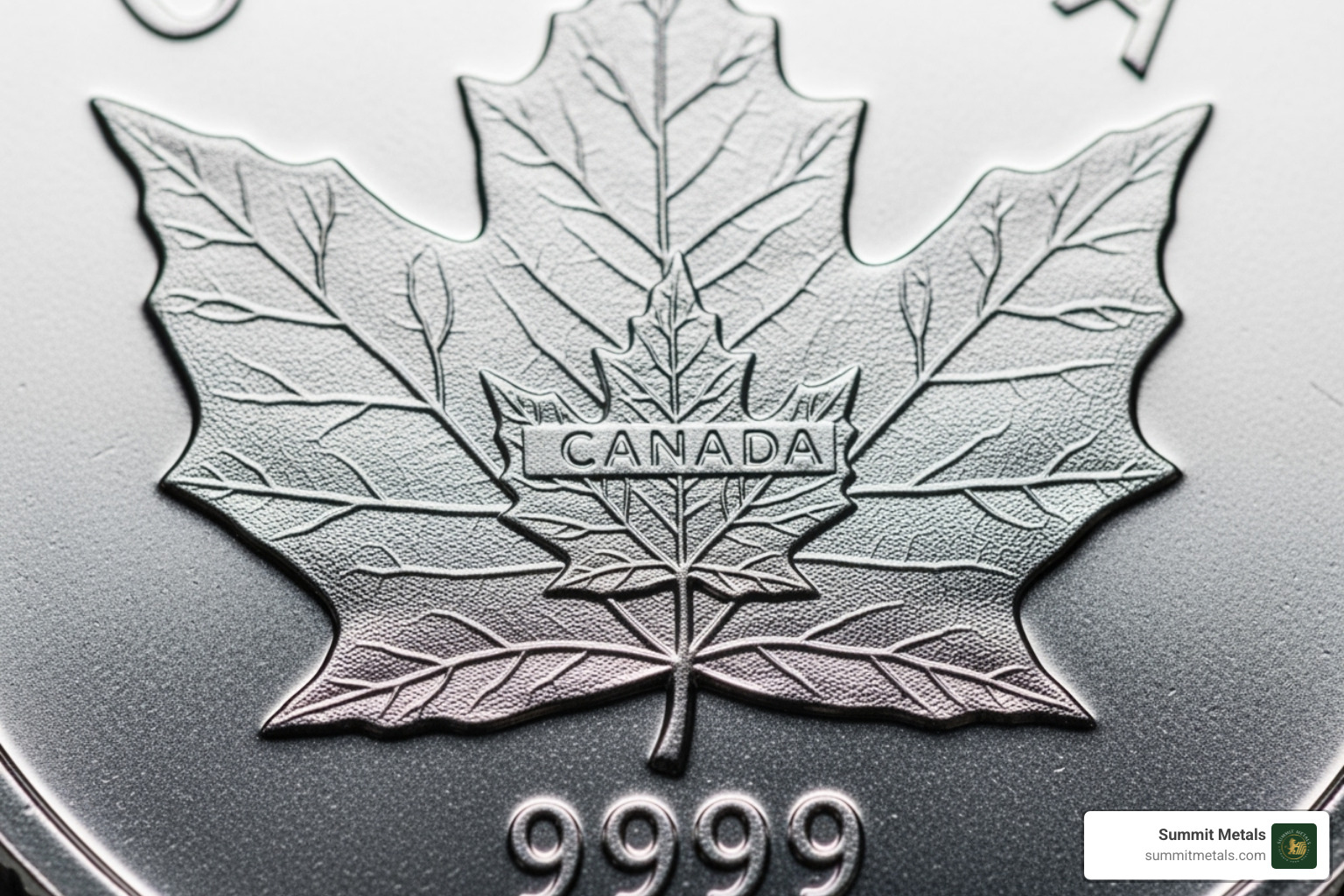
Furthermore, counterfeiting legal tender is a federal crime, carrying serious penalties. While the Hobby Protection Act requires replica rounds to be marked "COPY," they don't enjoy the same legal protections as coins. However, reputable private mints often include their own security features.
Your best defense remains simple: buy from reputable dealers. At Summit Metals, we authenticate every product, giving you confidence in every purchase.
Are Silver Coins and Rounds Suitable for an IRA?
Both silver coins and rounds can be held in a Precious Metals IRA, but the IRS has specific rules. The key requirement is purity: your silver must be .999 fine (99.9% pure) or greater.
IRA-approved coins like the American Silver Eagle and Canadian Silver Maple Leaf have a clear advantage, as they are explicitly approved by the IRS. Their government backing and guaranteed purity remove any guesswork.
Silver rounds can also qualify if they meet the .999 purity requirement and come from an approved refiner, but coins offer a more reliable path into your retirement account. All precious metals in an IRA must be stored in a secure, licensed third-party depository.
Building silver into your retirement strategy provides a hedge against inflation. Consistent investing through programs like Summit Metals' Autoinvest lets you dollar-cost average into precious metals just like you would with a 401k, building wealth steadily over time.
Ready to explore how silver fits into your retirement planning? Learn more about Precious Metals IRAs and find how to protect your future with physical silver.
Making Your Choice: Which is Right for You?
The decision between silver rounds vs coins comes down to your personal investment goals. Think of it like choosing between a reliable sedan and a sports car—both get you there, but they serve different purposes.
When to Choose Silver Coins
Silver coins are the "blue chip stocks" of the precious metals world—trusted and globally respected. Choose them if you prioritize:
- Security and Trust: The government backing of a coin provides a foundation of trust that's hard to shake.
- Liquidity: Coins like the American Silver Eagle or Canadian Silver Maple Leaf are instantly recognized and readily purchased by dealers worldwide, often at better buyback prices.
- Numismatic Potential: Coins can develop value beyond their silver content through rarity and collector demand, offering appreciation potential independent of silver prices.
Popular choices include the American Silver Eagle (learn more in Beyond the Shine: Why Invest in Silver Eagles), the Canadian Silver Maple Leaf, the British Britannia, and the Austrian Philharmonic.
When to Choose Silver Rounds
Silver rounds are for the practical investor who wants maximum silver for minimum cost. Choose them if you want to:
- Maximize Silver Weight: Lower premiums mean more silver in your safe for every dollar you invest.
- Lower Your Entry Cost: Rounds are attractive for new investors or those building their stack gradually without paying hefty premiums.
- Build Themed Collections: Private mints offer unlimited creative designs, from wildlife to historical events.
Popular options include the iconic Buffalo Round, Morgan Dollar Replica designs, and trusted Sunshine Mint Rounds.
For inspiration on classic designs, explore One Ounce of Freedom: Top Walking Liberty Silver Rounds to Own.
A Strategy for Both: Diversification and Autoinvest
You don't have to choose sides. The smartest approach often involves both. Build a foundation of cost-effective rounds for pure silver accumulation, then add recognized coins for liquidity and potential numismatic upside. This balanced approach gives you the best of both worlds.
Dollar-cost averaging is a proven investment strategy that works beautifully with precious metals. Summit Metals' Autoinvest program makes this effortless by automating your monthly silver purchases, just like contributing to a 401k.
With Autoinvest, you can set up consistent monthly investing that smooths out price volatility. Whether you prefer coins, rounds, or a mix, this approach helps you build wealth over time without trying to time the market. Over time, you'll achieve a reasonable average price while steadily growing your holdings.
Ready to start building your silver stack systematically? Learn more about Autoinvest with Summit Metals and find how easy it is to invest in precious metals on autopilot.
Comparison Charts to Help You Decide
Seeing the facts laid out side-by-side makes investment choices easier. These comparison charts clarify what you're getting with each option.
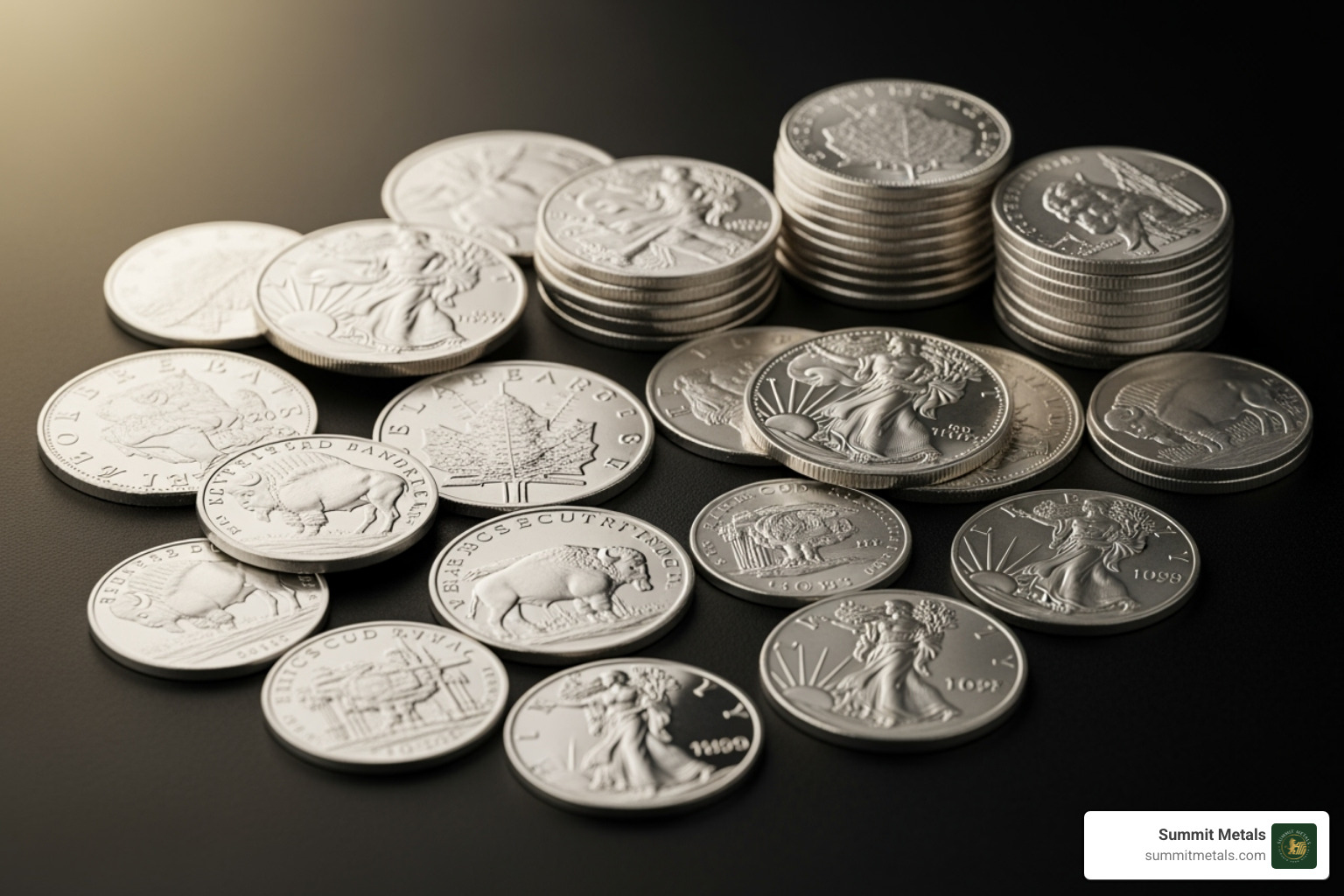
The silver round vs coin comparison comes down to your priorities. Government-backed coins offer security and recognition, and the higher premiums often translate to better resale values.
| Feature | Silver Coin | Silver Round |
|---|---|---|
| Minting Authority | Government Mint (e.g., U.S. Mint) | Private Mint (e.g., Sunshine Minting) |
| Legal Tender | Yes, with a face value | No |
| Premium | Generally higher over spot | Generally lower over spot |
| Primary Value | Silver content + collectibility/numismatic | Silver content |
| Liquidity | High (globally recognized) | Moderate to High (depends on recognition) |
| IRA Eligibility | Yes (many popular coins) | Yes (some reputable rounds) |
| Security Features | Advanced (micro-engravings, radial lines) | Varies (some have, many don't) |
| Resale Value | Often higher, better buyback prices | Closer to spot price, depends on market |
Silver rounds shine when you want maximum silver weight. The lower premium means more ounces in your stack, which adds up significantly over time for investors using dollar-cost averaging with our Autoinvest program.
The gold market follows similar patterns. Gold coins carry the same government backing, while gold bars offer benefits for serious stackers.

Here's where gold coins demonstrate their value. That face value isn't just a number—it's legal protection. Counterfeiting legal tender carries serious federal penalties, making gold coins a safer bet against fraud.
| Feature | Gold Coin | Gold Bar |
|---|---|---|
| Minting Authority | Government Mint | Private Mint |
| Legal Tender | Yes, with a face value | No |
| Fraud Protection | Strong (government backing, legal penalties) | Moderate (reputation of private mint) |
| Face Value Benefit | Guaranteed minimum value, widely accepted | No face value |
| Higher Weight Options | Limited to standard sizes (e.g., 1 oz) | Wide range (1 oz, 10 oz, 1 kg, etc.) |
| Premium | Generally higher over spot | Generally lower over spot |
Gold bars excel when storing significant wealth in a smaller space, as higher weight options offer storage efficiency and lower premiums. Many successful investors build diversified stacks using both coins and rounds (or bars), taking advantage of each option's strengths.
Frequently Asked Questions about Silver Round vs Coin
Here are some of the most common inquiries regarding silver round vs coin:
Why are silver rounds cheaper than silver coins?
The price difference is due to production costs and government backing. Silver rounds are cheaper because:
- Lower Overhead: Private mints operate more efficiently than large government facilities.
- No Legal Tender Costs: They don't incur the expenses of creating and maintaining official currency.
- Unlimited Mintage: Rounds can be produced based on demand, whereas coins often have mintage limits that create scarcity and drive up premiums.
Essentially, a round's price is tied almost exclusively to its silver content, while a coin's price includes the value of its government guarantee and collectibility.
Are silver rounds harder to sell than silver coins?
Silver coins are generally easier to sell. Their government backing and global recognition mean dealers worldwide will instantly recognize and buy them, often at higher buyback prices. This is especially true for popular coins like the American Silver Eagle.
However, reputable silver rounds from well-known mints (like the Silver Buffalo round) are still highly liquid and easy to sell. The main challenge arises with obscure or less common designs, which may require more effort to find a buyer. In times of market stress, the liquidity advantage of government coins becomes even more pronounced.
How can I tell if it's a silver coin or a round?
It's straightforward once you know what to look for. Check for these three things:
- Face Value: If it has a monetary denomination (e.g., "$1" or "5 DOLLARS"), it's a coin. Rounds have no face value.
- Minting Authority: Coins will name a country (e.g., "United States of America"). Rounds will name a private mint or have no mint mark.
- "COPY" Mark: Any round that imitates a historical U.S. coin design must be stamped with "COPY" by law.
A piece with a face value and a country's name is a government-issued coin. Anything else is a round.
Conclusion
The choice between silver round vs coin is about aligning your investment with your personal goals. Both are solid pathways to owning physical silver.
| Attribute | Silver Coin | Silver Round |
|---|---|---|
| Minting Authority | Government Mint | Private Mint |
| Legal Tender | Yes | No |
| Premium | Higher | Lower |
| Primary Value | Silver Content + Numismatic Value | Silver Content |
| Liquidity | High | Moderate |
| IRA Eligibility | Yes (many popular options) | Yes (some reputable options) |

There's no single "winner." Your best choice depends on your priorities.
- Silver Rounds are ideal for maximizing your silver weight for every dollar spent, thanks to lower premiums.
- Silver Coins excel for those who prioritize liquidity, government backing, and potential numismatic appreciation.
Many seasoned investors build diversified portfolios with both coins and rounds. This strategy becomes even more powerful with dollar-cost averaging through our Autoinvest program. Like a 401k, you can automatically purchase silver monthly, smoothing out price fluctuations while steadily building your wealth.
At Summit Metals, we've built our reputation on transparent, real-time pricing and competitive rates. Whether you choose an American Silver Eagle or a Buffalo Round, we authenticate every piece we sell, ensuring you get exactly what you pay for.
Learn more about what silver to buy and why liquidity matters and see how Summit Metals can support your investment journey.



